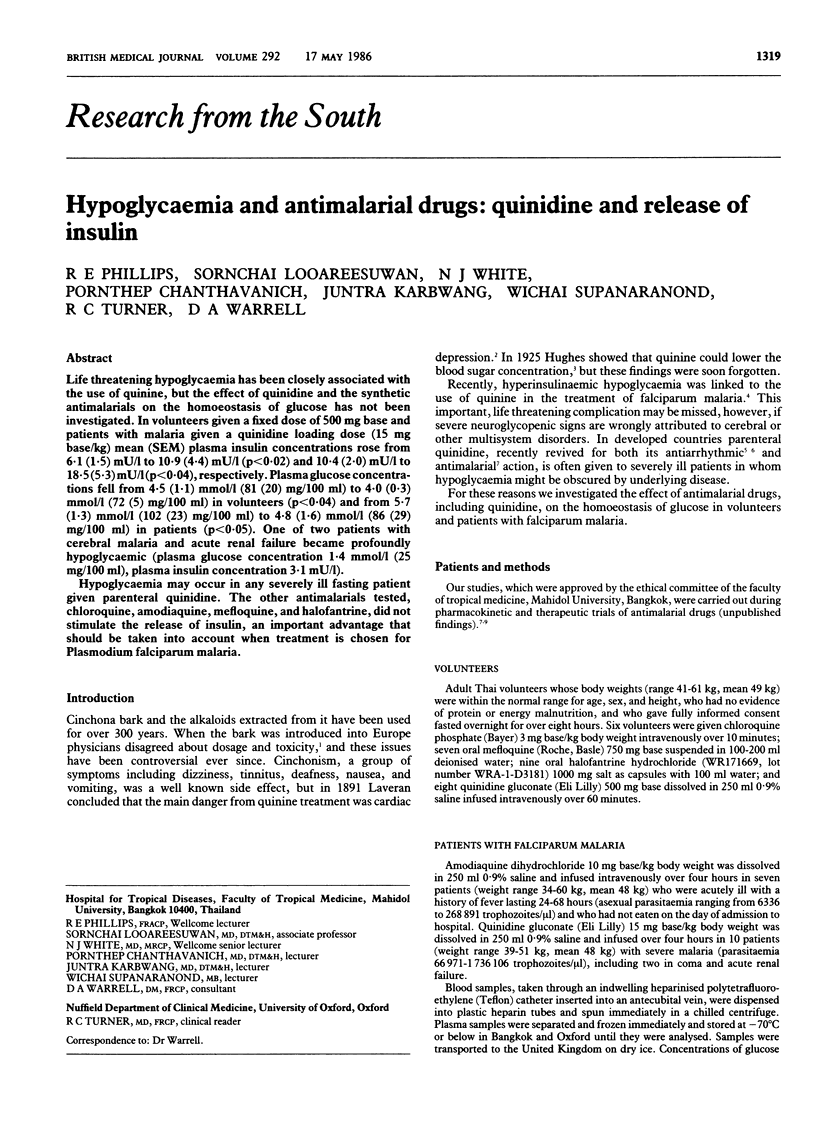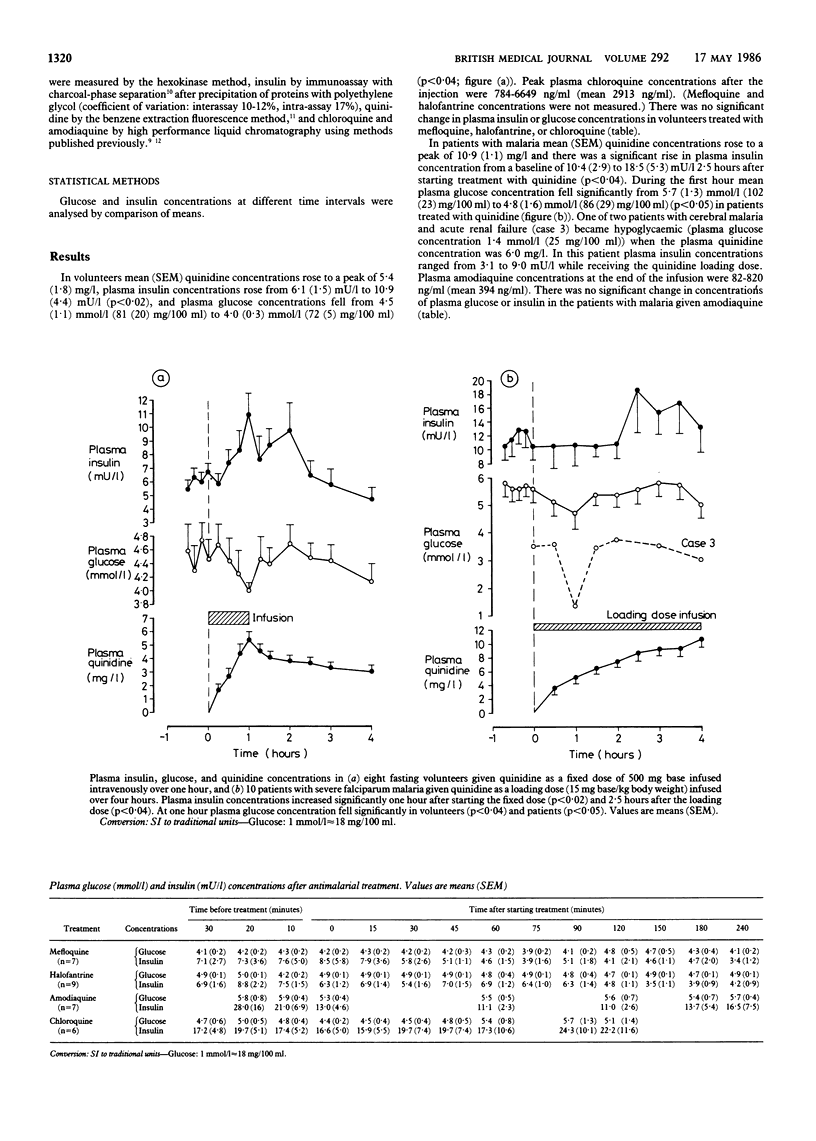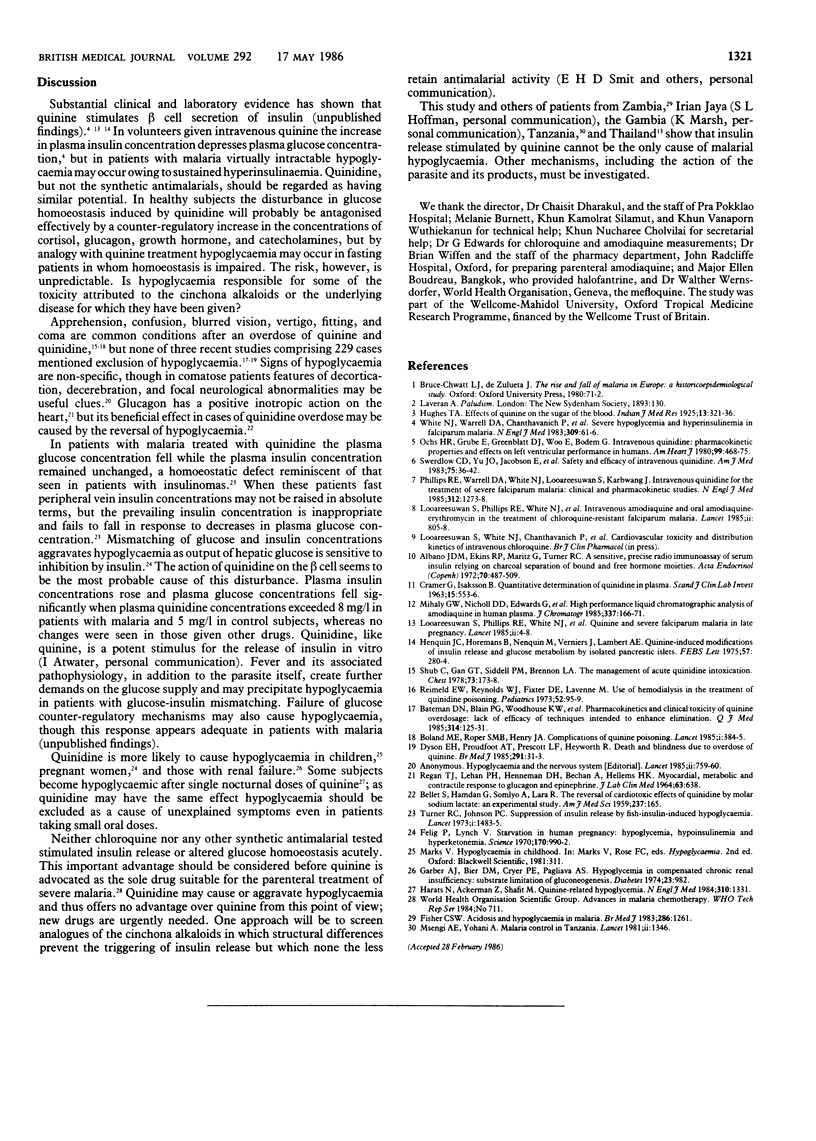Abstract
Life threatening hypoglycaemia has been closely associated with the use of quinine, but the effect of quinidine and the synthetic antimalarials on the homoeostasis of glucose has not been investigated. In volunteers given a fixed dose of 500 mg base and patients with malaria given a quinidine loading dose (15 mg base/kg) mean (SEM) plasma insulin concentrations rose from 6.1 (1.5) mU/l to 10.9 (4.4) mU/l (p less than 0.02) and 10.4 (2.0) mU/l to 18.5 (5.3) mU/l (p less than 0.04), respectively. Plasma glucose concentrations fell from 4.5 (1.1) mmol/l (81 (20) mg/100 ml) to 4.0 (0.3) mmol/l (72 (5) mg/100 ml) in volunteers (p less than 0.04) and from 5.7 (1.3) mmol/l (102 (23) mg/100 ml) to 4.8 (1.6) mmol/l (86 (29) mg/100 ml) in patients (p less than 0.05). One of two patients with cerebral malaria and acute renal failure became profoundly hypoglycaemic (plasma glucose concentration 1.4 mmol/l (25 mg/100 ml), plasma insulin concentration 3.1 mU/l). Hypoglycaemia may occur in any severely ill fasting patient given parenteral quinidine. The other antimalarials tested, chloroquine, amodiaquine, mefloquine, and halofantrine, did not stimulate the release of insulin, an important advantage that should be taken into account when treatment is chosen for Plasmodium falciparum malaria.
Full text
PDF


Selected References
These references are in PubMed. This may not be the complete list of references from this article.
- Albano J. D., Ekins R. P., Maritz G., Turner R. C. A sensitive, precise radioimmunoassay of serum insulin relying on charcoal separation of bound and free hormone moieties. Acta Endocrinol (Copenh) 1972 Jul;70(3):487–509. doi: 10.1530/acta.0.0700487. [DOI] [PubMed] [Google Scholar]
- BELLET S., HAMDAN G., SOMLYO A., LARA R. The reversal of cardiotoxic effects of quinidine by molar sodium lactate: an experimental study. Am J Med Sci. 1959 Feb;237(2):165–passim. doi: 10.1097/00000441-195902000-00004. [DOI] [PubMed] [Google Scholar]
- Bateman D. N., Blain P. G., Woodhouse K. W., Rawlins M. D., Dyson H., Heyworth R., Prescott L. F., Proudfoot A. T. Pharmacokinetics and clinical toxicity of quinine overdosage: lack of efficacy of techniques intended to enhance elimination. Q J Med. 1985 Feb;54(214):125–131. [PubMed] [Google Scholar]
- CRAMER G., ISAKSSON B. QUANTITATIVE DETERMINATION OF QUINIDINE IN PLASMA. Scand J Clin Lab Invest. 1963;15:553–556. doi: 10.1080/00365516309079786. [DOI] [PubMed] [Google Scholar]
- Dyson E. H., Proudfoot A. T., Prescott L. F., Heyworth R. Death and blindness due to overdose of quinine. Br Med J (Clin Res Ed) 1985 Jul 6;291(6487):31–33. doi: 10.1136/bmj.291.6487.31. [DOI] [PMC free article] [PubMed] [Google Scholar]
- Garber A. J., Bier D. M., Cryer P. E., Pagliara A. S. Hypoglycemia in compensated chronic renal insufficiency. Substrate limitation of gluconeogenesis. Diabetes. 1974 Dec;23(12):982–986. doi: 10.2337/diab.23.12.982. [DOI] [PubMed] [Google Scholar]
- Harats N., Ackerman Z., Shalit M. Quinine-related hypoglycemia. N Engl J Med. 1984 May 17;310(20):1331–1331. doi: 10.1056/NEJM198405173102018. [DOI] [PubMed] [Google Scholar]
- Henquin J. C., Horemans B., Nenquin M., Verniers J., Lambert A. E. Quinine-induced modifications of insulin release and glucose metabolism by isolated pancreatic islets. FEBS Lett. 1975 Oct 1;57(3):280–284. doi: 10.1016/0014-5793(75)80317-6. [DOI] [PubMed] [Google Scholar]
- Looareesuwan S., Phillips R. E., White N. J., Karbwang J., Benjasurat Y., Attanath P., Warrell D. A. Intravenous amodiaquine and oral amodiaquine/erythromycin in the treatment of chloroquine-resistant falciparum malaria. Lancet. 1985 Oct 12;2(8459):805–808. doi: 10.1016/s0140-6736(85)90796-2. [DOI] [PubMed] [Google Scholar]
- Ochs H. R., Grube E., Greenblatt D. J., Woo E., Bodem G. Intravenous quinidine: pharmacokinetic properties and effects on left ventricular performance in humans. Am Heart J. 1980 Apr;99(4):468–475. doi: 10.1016/0002-8703(80)90381-6. [DOI] [PubMed] [Google Scholar]
- Phillips R. E., Warrell D. A., White N. J., Looareesuwan S., Karbwang J. Intravenous quinidine for the treatment of severe falciparum malaria. Clinical and pharmacokinetic studies. N Engl J Med. 1985 May 16;312(20):1273–1278. doi: 10.1056/NEJM198505163122001. [DOI] [PubMed] [Google Scholar]
- REGAN T. J., LEHAN P. H., HENNEMAN D. H., BEHAR A., HELLEMS H. K. MYOCARDIAL METABOLIC AND CONTRACTILE RESPONSE TO GLUCAGON AND EPINEPHRINE. J Lab Clin Med. 1964 Apr;63:638–647. [PubMed] [Google Scholar]
- Reimold E. W., Reynolds W. J., Fixler D. E., McElroy L. Use of hemodialysis in the treatment of quinidine poisoning. Pediatrics. 1973 Jul;52(1):95–99. [PubMed] [Google Scholar]
- Swerdlow C. D., Yu J. O., Jacobson E., Mann S., Winkle R. A., Griffin J. C., Ross D. L., Mason J. W. Safety and efficacy of intravenous quinidine. Am J Med. 1983 Jul;75(1):36–42. doi: 10.1016/0002-9343(83)91165-8. [DOI] [PubMed] [Google Scholar]
- Turner R. C., Johnson P. C. Suppression of insulin release by fish-insulin-induced hypoglycaemia: with reference to the diagnosis of insulinomas. Lancet. 1973 Jun 30;1(7818):1483–1485. doi: 10.1016/s0140-6736(73)91817-5. [DOI] [PubMed] [Google Scholar]


